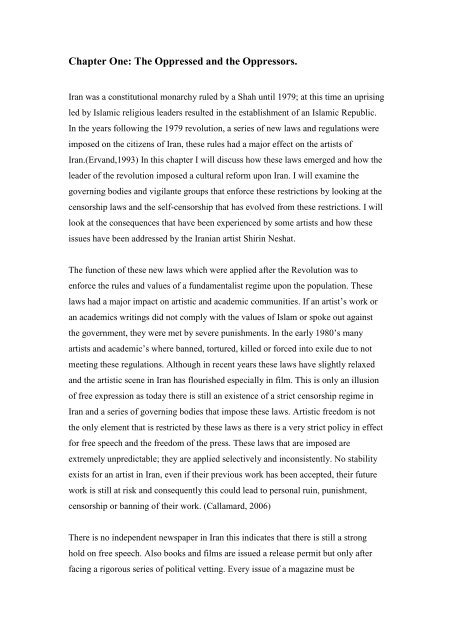A Gaze through the Veil:
A Gaze through the Veil:
A Gaze through the Veil:
You also want an ePaper? Increase the reach of your titles
YUMPU automatically turns print PDFs into web optimized ePapers that Google loves.
Chapter One: The Oppressed and <strong>the</strong> Oppressors.Iran was a constitutional monarchy ruled by a Shah until 1979; at this time an uprisingled by Islamic religious leaders resulted in <strong>the</strong> establishment of an Islamic Republic.In <strong>the</strong> years following <strong>the</strong> 1979 revolution, a series of new laws and regulations wereimposed on <strong>the</strong> citizens of Iran, <strong>the</strong>se rules had a major effect on <strong>the</strong> artists ofIran.(Ervand,1993) In this chapter I will discuss how <strong>the</strong>se laws emerged and how <strong>the</strong>leader of <strong>the</strong> revolution imposed a cultural reform upon Iran. I will examine <strong>the</strong>governing bodies and vigilante groups that enforce <strong>the</strong>se restrictions by looking at <strong>the</strong>censorship laws and <strong>the</strong> self-censorship that has evolved from <strong>the</strong>se restrictions. I willlook at <strong>the</strong> consequences that have been experienced by some artists and how <strong>the</strong>seissues have been addressed by <strong>the</strong> Iranian artist Shirin Neshat.The function of <strong>the</strong>se new laws which were applied after <strong>the</strong> Revolution was toenforce <strong>the</strong> rules and values of a fundamentalist regime upon <strong>the</strong> population. Theselaws had a major impact on artistic and academic communities. If an artist’s work oran academics writings did not comply with <strong>the</strong> values of Islam or spoke out against<strong>the</strong> government, <strong>the</strong>y were met by severe punishments. In <strong>the</strong> early 1980’s manyartists and academic’s where banned, tortured, killed or forced into exile due to notmeeting <strong>the</strong>se regulations. Although in recent years <strong>the</strong>se laws have slightly relaxedand <strong>the</strong> artistic scene in Iran has flourished especially in film. This is only an illusionof free expression as today <strong>the</strong>re is still an existence of a strict censorship regime inIran and a series of governing bodies that impose <strong>the</strong>se laws. Artistic freedom is not<strong>the</strong> only element that is restricted by <strong>the</strong>se laws as <strong>the</strong>re is a very strict policy in effectfor free speech and <strong>the</strong> freedom of <strong>the</strong> press. These laws that are imposed areextremely unpredictable; <strong>the</strong>y are applied selectively and inconsistently. No stabilityexists for an artist in Iran, even if <strong>the</strong>ir previous work has been accepted, <strong>the</strong>ir futurework is still at risk and consequently this could lead to personal ruin, punishment,censorship or banning of <strong>the</strong>ir work. (Callamard, 2006)There is no independent newspaper in Iran this indicates that <strong>the</strong>re is still a stronghold on free speech. Also books and films are issued a release permit but only afterfacing a rigorous series of political vetting. Every issue of a magazine must be




